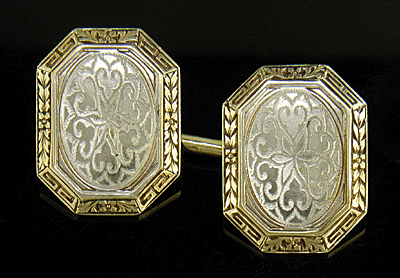Featured this week are several of the frosty cufflinks created by Charles Keller & Co. during the early 1900s. Above is a nice example with the radiating spiral motif popular during the Art Deco period. These cufflinks are crafted with platinum tops and 14kt gold backs. The platinum tops are beautifully engine-turned with swirling radiant spirals. The radiant centers are accented with black enamel and surrounded by flowing leaf-and-vine borders. Crafted in 14kt gold and platinum, circa 1920.
The cufflinks were created by Charles Keller & Company. Founded in 1885, Charles Keller manufactured gold and platinum cufflinks, lockets and other jewels in workshops based in Newark, New Jersey. During the early decades of the last century, the firm specialized in creating elegant cufflinks with intricately engraved platinum or white gold surfaces. Charles Keller remained in business until the early 1930s.
The cross bars are stamped with the precious metal mark for platinum, "PLAT". To the right of the platinum mark is the maker's mark of Charles Keller & Company, an elongated "C" followed by the letter "K". In side the "C" is a karat mark, "14", for the purity of the gold.
Every so often the Charles Keller mark is misidentified as the mark of another fine cufflink maker, Carrington & Company. The Carrington mark also has a "14" surrounded by a "C" . However, in the Carrington mark the "C" is squarish and angular, not elongated and rounded like the Keller mark. As always, care should be taken when reading and interpreting makers' marks.
Here is a second pair of beautifully engraved Charles Keller cufflinks. The platinum tops are engine turned with a stippled pattern of concentric circles. This gives the cufflinks a frosty, shimmering appearance. The stylized flower (or star) motifs were created by leaving areas of the brightly polished platinum unstippled. The border is a classic egg-and-dart pattern recalling the Beaux-Arts style of the late 1800s. Crafted in platinum and 14kt gold, circa 1920.





